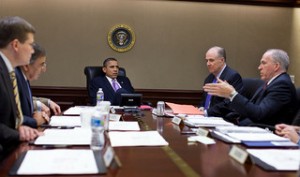Flaunting Shakeel Afridi’s CIA Ties Appears Not to Have Worked All that Well
When Leon Panetta went on 60 Minutes and confirmed Pakistani doctor Dr. Shakeel Afridi was working for the US when he faked vaccinations in Abbottbad to collect information from Osama bin Laden’s compound, I noted the hypocrisy of his public confirmation of the CIA role, but assumed the Administration had approved the confirmation.
Meanwhile, tomorrow the above clip will be shown on 60 Minutes, showing Panetta confirming that the Pakistani doctor who conducted fake vaccinations in Abbottabad, Pakistan in order to get a glimpse into Osama bin Laden’s compound was, in fact, working for the CIA.
Panetta also acknowledged that Shikal Afridi, the Pakistani doctor conducting health tests in the village in an effort to collect DNA and verify bin Laden’s presence, was in fact working for the U.S. Afridi was arrested and charged with treason by the government of Pakistan. “I’m very concerned about what the Pakistanis did with this individual…who in fact helped provide intelligence that was very helpful with regards to this operation,” says Panetta. “He was not in any way treasonous towards Pakistan…Pakistan and the United States have a common cause here against terrorism…and for them to take this kind of action against somebody who was helping to go after terrorism, I just think is a real mistake on their part,” he tells Pelley.
Not only does this presumably put more pressure on Pakistan to convict Afridi of treason (he remains in custody), but it exacerbates the problem of having used a vaccination campaign as cover in the first place, confirming on the record that similar campaigns in poor countries might be no more than a CIA front.
I presume someone in the White House gave Panetta permission to go blab this on 60 Minutes; I assume he’s in no more legal jeopardy than Dick Cheney was when he insta-declassified Valerie Plame’s identity.
I suppose that last line–“I just think [arresting Afridi] is a real mistake on their part”–was intended as an implicit threat.
But Panetta’s move–going on TV to suggest that Pakistan was wrong to prosecute one of its citizens working as a spy for the US–risked making it harder for Pakistani authorities to release Afridi by publicizing the ties (in the analogous situation with Ray Davis, the Administration demanded the US press hold all stories confirming Davis’ ties).
Moreover, between the time the Pakistanis arrested Afridi and the time Panetta made these statements, the US arrested Syed Ghulam Nabi Fai for serving as an unregistered foreign agent, then convicted him in December on conspiracy and IRS charges. Yes, he was allowed to plead to lesser charges; yes, he was ultimately sentenced to only 2 years. But Fai’s prosecution made it clear we insist on sovereignty even in matters of political influence, much less spying a mile or so from a key military academy.
In any case, it didn’t work. As Jim has already noted, today Pakistan sentenced Afridi to a whopping 33 years in prison for treason.
Funny how other nations don’t like being told our covert operations should take precedence over their sovereignty.
Update: In a joint statement, Carl Levin and John McCain have suggested Pakistan may lose funding over this:
It is shocking and outrageous that Dr. Shakil Afridi, the Pakistani doctor who assisted the United States in the search for Osama bin Laden, has been sentenced to 33 years in prison for the crime of treason. What Dr. Afridi did is the furthest thing from treason. It was a courageous, heroic, and patriotic act, which helped to locate the most wanted terrorist in the world – a mass murderer who had the blood of many innocent Pakistanis on his hands.
Dr. Afridi’s actions were completely consistent with the multiple, legally-binding resolutions passed over many years by the United Nations Security Council, which required member-states to assist in bringing Osama bin Laden and his Al-Qaeda network to justice. Dr. Afridi set an example that we wish others in Pakistan had followed long ago. He should be praised and rewarded for his actions, not punished and slandered.
We call upon the Pakistani government to pardon and release Dr. Afridi immediately. At a time when the United States and Pakistan need more than ever to work constructively together, Dr. Afridi’s continuing imprisonment and treatment as a criminal will only do further harm to U.S.-Pakistani relations, including diminishing Congress’s willingness to provide financial assistance to Pakistan. [my emphasis]

